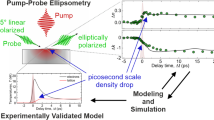Abstract
Non-equilibrium energy transport in the surface region of the metallic substrate occurs due to a laser irradiation, which in turn results in thermal separation of electron and lattice sub-systems. As the heating period exceeds the thermal relaxation time, both sub-systems become thermally in equilibrium having the identical temperatures. When electron and lattice temperatures become identical the corresponding instant can be called thermal equilibrium time. In the present study, an analytical formulation of lattice site temperature distribution in the domain of thermal equilibrium time is obtained. Temperature differences and temperature distributions in electron and lattice sub-systems are computed for gold. It is found that electron and lattice temperatures become identical for the heating period beyond the thermal equilibrium time. Temperature distribution obtained from the analytical solution and numerical predictions agree well.




Similar content being viewed by others
Abbreviations
- C e :
-
Electron heat capacity (J/m3 K)
- C l :
-
Lattice heat capacity (J/m3 K)
- G :
-
Electron–phonon coupling factor (W/m3 K)
- I 1 :
-
Peak amplitude of power intensity (W/m2)
- I 0 :
-
Exponentially decaying laser pulse intensity (W/m2)
- T e :
-
Electron temperature (K)
- T l :
-
Lattice site temperature (K)
- T 0 :
-
Reference temperature (300 K)
- k :
-
Thermal conductivity (W/m K)
- t :
-
Time (s)
- x :
-
Distance (m)
- α, β:
-
Exponentially decaying laser pulse intensity parameters (1.s)
- δ:
-
Absorption length (1/m)
References
Agranat MB, Benditskii AA, Gandel’man GM, Devyatkov AG, Kondratenko PS, Makshantsev BI, Rukman GI, Stepanov BM (1979) Noninertial radiation from metals in interaction with ultrashort pulses of coherent infrared radiation. JETP Lett 30:167–169
Eesley GL (1986) Generation of nonequilibrium electron and lattice temperatures in copper by picosecond laser pulses. Phys Rev B 33:2144–2151
Allen PB (1987) Theory of thermal relaxation of electrons in metals. Phys Rev Lett 59:1460–1463
Elsayed-Ali HE, Norris TB, Pessot MA, Mourou GA (1987) Time-resolved observation of electron–phonon relaxation in copper. Phys Rev Lett 58:1212–1215
Qiu TQ, Tien L (1994) Femtosecond laser heating of multi-layer metals-I analysis. Int J Heat Mass Transfer 37:2789–2797
Wang XY, Riffe DM, Lee YS, Downer MC (1994) Time-resolved electron-temperature measurement in a highly excited gold target using femtosecond thermionic emission. Phys Rev B 50:8016–8019
Lin C, Hwang C, Chang Y (1997) The unsteady solutions of a unified heat conduction equation. Int J Heat Mass Transfer 40:1716–1719
Al-Nimr MA, Masoud SA (1997) Nonequilibrium laser heating of metal films. ASME J Heat Transfer 119:188–190
Wang L (2000) Solution structure of hyperbolic heat-conduction equation. Int J Heat Mass Transfer 43:365–373
Yilbas BS (1986) Heating of metals at a free surface by laser radiation an electron kinetic theory approach. Int J Eng Sci 24(8):1325–1334
Yilbas BS (2004) Entropy analysis and improved formulation of electron kinetic theory approach for laser short-pulse heating. Numer Heat Transfer Part B 45:75–98
Yilbas BS, Hyder SJ, Kalyon M (2001) Laser shortpulse heating: determination of lagging time due to different pulse parameters. Int Comm Heat Mass Transfer 28:815–822
Abramowitz M, Stegun IA (1965) Handbook of mathematical functions. Dover, New York
Acknowledgements
Acknowledgements are due to King Fahd University of Petroleum and Minerals for the support of the work.
Author information
Authors and Affiliations
Corresponding author
Rights and permissions
About this article
Cite this article
Kalyon, M., Yilbas, B.S. An approach for analytical solution pertinent to lattice temperature variation due to laser short-pulse heating. Heat Mass Transfer 42, 1111–1117 (2006). https://doi.org/10.1007/s00231-005-0071-9
Received:
Accepted:
Published:
Issue Date:
DOI: https://doi.org/10.1007/s00231-005-0071-9




